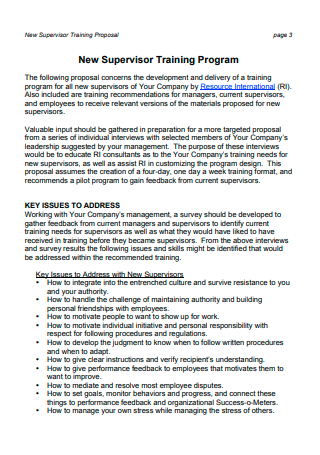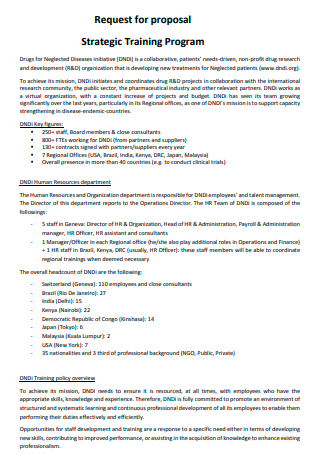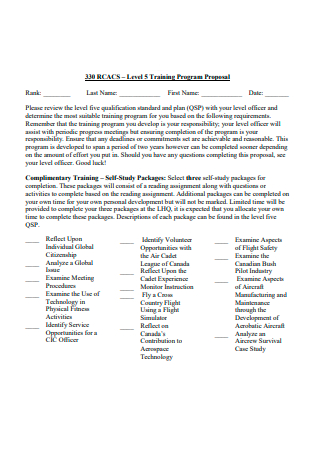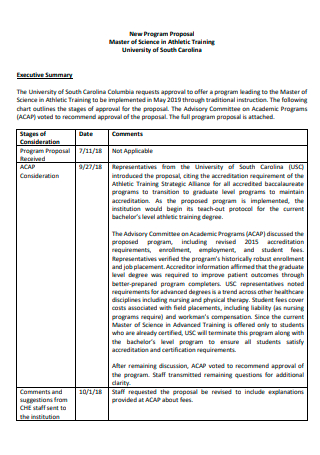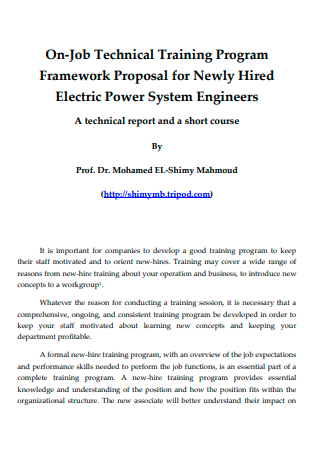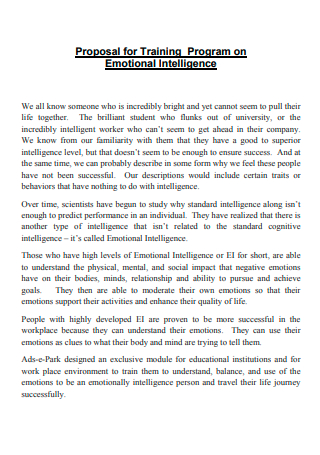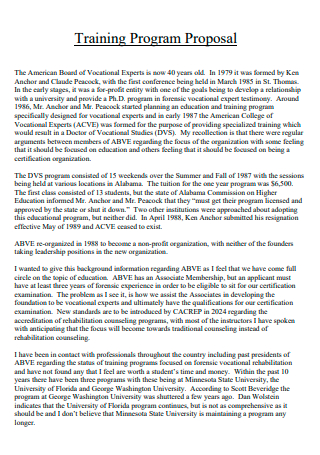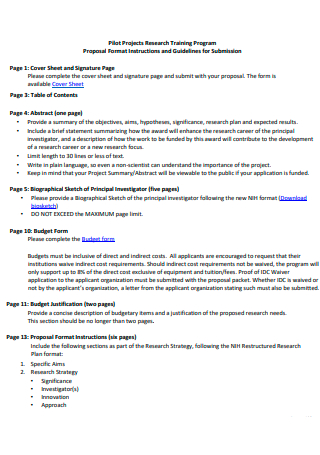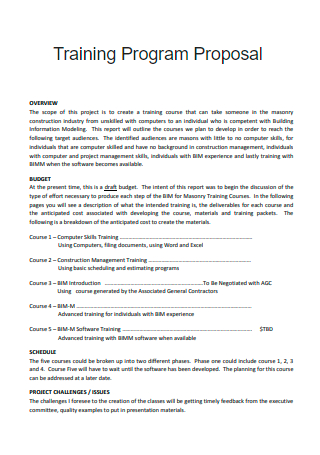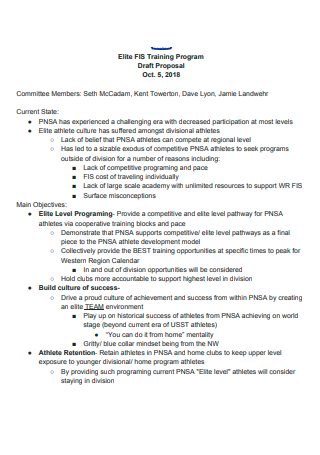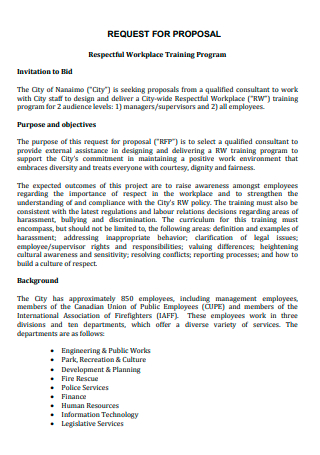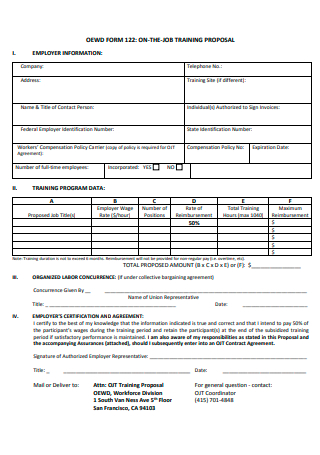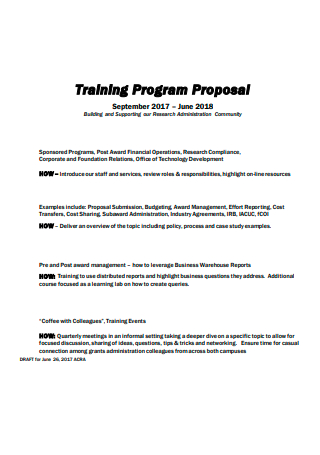13+ Sample Training Program Proposal
FREE Training Program Proposal s to Download
What Is a Training Program Proposal?
A training proposal is a document provided to businesses that provide professional development and corporate training to a potential client. It is intended to persuade prospective clients to engage in corporate training or professional development. According to statistics, training and development assist businesses in attracting and retaining top personnel, increasing job satisfaction and morale, increasing productivity, and increasing profit. Additionally, organizations with engaged and committed staff have a 41% reduction in absenteeism and a 17% increase in productivity.
Benefits of Training Programs
Some institutes prepare graduates to lead HR teams in implementing and executing policies that promote employee responsibility, production, satisfaction, and retention and programs that engage employees through consistent training and development, catering to busy working adults with limited time for school. They’ll be aware of the advantages of training and development – the top five of which are listed below – in assisting their companies in achieving their strategic objectives.
Employee Retention Through Training: Businesses have significant retention challenges, yet career development can help employers retain employees. Indeed, training and development have become so ingrained in firms that they are frequently employed as a competitive advantage in the hiring process. Offering professional development opportunities helps employees create a sense of worth and loyalty, resulting in higher staff retention and a 59 percent lower staff turnover rate.Training Fosters the Development of Future Leaders: Employing individuals with the potential for future leadership might be critical in developing a corporation capable of growth and change. Human resource specialists can obtain leadership talent by hiring or selecting current employees as managerial candidates. According to research, establishing leadership development programs enables a company to remain focused on future business objectives by developing promotable talent.Employees Are Empowered Through Training: Leaders that feel empowered in the workplace are more effective at influencing and gaining the trust of their staff. As a result, those employees will experience increased autonomy, value, and confidence in their work. According to some, employee autonomy refers to an employee’s sense of independence and ability to make their own decisions regarding their work.Training Increases Employee Engagement: Finding measures to increase employees’ constant involvement can help alleviate workplace boredom, which, if left unchecked, can result in sentiments of unhappiness and undesirable work habits. Regular training and development programs can help firms avoid workplace idleness and promote a culture of continuous review of their personnel, abilities, and processes. Additionally, it will influence business culture by focusing on planning and driving company analysis and planning by requiring employers to analyze current personnel and growth and development potential internally rather than through recruitment.Training Facilitates the Development of Workplace Relationships: By delivering opportunities for employees to learn new skills, improve their abilities, and broaden their knowledge, you may help your team members form bonds. They will collaborate on new issues throughout these training and development sessions. Additionally, they can use one another for diverse learning opportunities by collaborating with colleagues who specialize in particular areas of knowledge. Peer collaboration is their favorite technique of learning. Not only does learning from one another’s skills result in a more balanced staff, but such ties can also help with retention and engagement.Training enhances your organization’s reputation: Competition for certain positions might be intimidating. Your firm must establish a strong reputation for treating people properly to recruit new employees, particularly millennials, successfully. By providing ongoing training, you demonstrate to current and prospective employees that your firm has a forward-thinking organizational culture and management style. They will view your firm as a long-term employer that is caring and eager to invest in its personnel. This type of favorable reputation is priceless in the employment market. According to research, approximately 70% of job applicants research an organization’s reputation before applying. Over 80% of employed professionals stated that they would leave their current job to work for a company with a good reputation. Said, your desire to provide training will assist you in obtaining a more robust workforce. Perhaps most crucially, this well-earned positive image helps to attract not only high-level professionals but also the ideal type of job seeker—individuals seeking to improve themselves.Training helps develop your in-house talent: Stagnation is a critical component of the workplace disaster recipe. When duties become routine, responsibilities become stale, and workdays become indistinguishable from one another, something potentially catastrophic occurs. Your team members are becoming dissatisfied. They’ve lost their inspiration and begun to slack off. They’re no longer engaged at work, and they’re probably not interested in learning about opportunities for advancement inside your firm. They might even be actively seeking employment elsewhere. Your brilliant employees deserve the opportunity to expand their skillset and take on new tasks or even change their career trajectory. Training enables you to enhance your existing workforce’s strengths and address their flaws head-on. It allows employees to acquire the abilities that will enable them to advance to a more senior position within your firm. After all, internal promotion is more efficient. Additionally, if your firm fosters a culture of continual learning and progress, people will gladly share knowledge, geometrically increasing the return on your investment. Enhancing one’s abilities will surely benefit others.
Elements of an Effective Training Program
When an incident occurs, the appropriate response is frequently training, followed by additional training. Each year, we spend wealth on activity across all industries. The first section discusses training, administration, and management. The second section describes roles and duties and details the processes for analyzing training needs. Also, it discusses the procedures for constructing the program, such as design, development, and execution, and how to assess the program’s effectiveness and ensure that it achieves the desired results—the third section of the standard addresses the requirement for continuing course development and maintenance. So, where should we begin? The process of developing a successful training program consists of eight steps.
Construct a business case: A standard error that safety professionals make when launching any new project is neglecting to develop a business case. Businesses exist to generate revenue. Any new program or expense must be weighed against the initiative’s overall worth to the firm. Conducting a cost-benefit analysis or building a formal business case to ascertain the financial value of training is mandatory.Create learning objectives and outcomes: The objectives and learning outcomes specify what learners will know and do following the training. Additionally, the learning outcomes should define the criteria for determining the training’s success. The training objectives and results should be matched with the position skill profile of the individual and, at a high level, with the organization’s business vision and mission.Create educational content and design: The most effective education and training techniques for a given context must be used. In today’s work environment, a mix of asynchronous online education and on-the-job training may be a more effective, cost-efficient, and accessible solution than traditional classroom education. Add to this some on-the-job training that incorporates tutoring and mentoring, and you may accomplish optimal instructional delivery. Numerous more distribution techniques, such as video, video conferencing, webinars, and other computer-based training tools, are available and should be examined.Internal and external resources are accessible: Training might be delivered in-house or by an external consultant. In-house trainers are less expensive because their wage is already factored into the company budget. While an in-house trainer may offer greater flexibility and a better understanding of the issues driving the need for training, external consultants who are more talented and polished presenters are also available. Utilizing an external resource may provide “just enough” separation between the subject at hand and the trainer to keep the classroom dialogue objective.Create materials for teaching and training: The course’s education and training materials must be carefully linked with the course’s objectives and learning outcomes. The learning activities should allow students to apply the concepts acquired in class. To be effective, the teacher must grasp the audience, the organization’s culture, and the history of the training’s necessity. Adults learn differently than younger pupils, and understanding the difficulties associated with adult education and training will improve training efficacy.Transfer information, abilities, and capabilities: The student must have the opportunity to use and display new talents, knowledge immediately, and skills acquired in the job. To ensure the program’s effectiveness, barriers that may inhibit prompt and practical application must be identified and removed. It is critical to have a support program that includes tutoring and mentoring by managers and supervisors. The total efficacy of the new abilities will be boosted if they are accompanied by a work and task observation approach that includes reinforcement.Assess efficacy: What is quantified is accomplished. It is vital to assess the effectiveness of education and training. Measurement substantiates and hopefully verifies the business case for training. While the total cost of the training is straightforward to calculate, it is critical to additionally track uptake and participant satisfaction. The adoption rate can be determined by completing post-training assessments and exhibiting newly acquired skills and abilities. Also, job observation can be utilized to evaluate skill improvement. Learners can provide comments on courses via course evaluation forms. As for performance improvement indicators, complex assessment methods may incorporate trailing indicators, such as decreased incident and damage data.Continuously improve: Continuous improvement is the final step in any such process. The enhancements may involve changing and upgrading education and training materials and tweaking teacher delivery and messaging. Often, the method by which learning is measured must be modified over time to maximize the value of the measurement results. The evaluation process’s findings must be used to make meaningful modifications to the objectives, learning outcomes, content, and instructional design.
How To Have an Effective Training Program
A systematic, step-by-step process should develop an effective employee training program. Individual training initiatives frequently fall short of meeting organizational objectives and participant expectations. With today’s increasingly remote workforce, the requirement for practical, ongoing training that may be delivered online is critical. Today’s rapid-fire advice piece outlines the five essential steps for developing effective training programs that positively influence the business and drive toward a holistic experience management strategy.
-
1. Determine training requirements
It is necessary to identify and assess needs to develop a training program. Employee training requirements may have been placed before in the organization’s strategic, human resource, or individual development goals. If, on the other hand, you’re developing the training program from scratch (without predefined objectives), you’ll need to select which areas to prioritize.
2. Establish training objectives for the organization
The training needs assessment identifies gaps in your current training activities and employee skill sets. These shortages should be remembered, prioritized, and translated into training objectives for the organization. The foremost goal is to close the gap between current performance/knowledge and desired performance/knowledge by developing a training program with business objectives at its center. At the employee level, training should be tailored to the identified areas for development. This can be determined extensively through feedback forms and reviews.
3. Create an action plan for training
The following phase develops a comprehensive action plan incorporating learning theories, instructional design, content, and other training components. Also, resources and methods of training delivery should be specified. While developing the program, it is necessary to consider the training level and the participants’ learning styles. Numerous businesses test their initiatives and gather feedback to make essential improvements before rolling out the program company-wide.
4. Organize training sessions
The implementation phase is the stage during which the training program takes shape. Organizations must determine whether to deliver training in-house or through external coordination. Employee engagement and learning KPI goals should be considered during program implementation, as should the scheduling of training events and any associated resources. The training program is formally established, marketed, and conducted. Throughout the training period, participant progress should be tracked to confirm the program’s effectiveness.
5. Evaluate and revise instruction
As noted previously, the training program should be monitored continuously. Finally, the complete program should be reviewed to verify its effectiveness and compliance with training objectives. Feedback from all stakeholders should be gathered to ascertain the program’s and instructor’s effectiveness and knowledge or skill acquisition. The business will identify program gaps and develop a more effective plan in analyzing this input in conjunction with an employee performance assessment. At this point, if objectives or expectations are not being fulfilled, the training program or action plan can be amended or re-assessed.
FAQs
What is the definition of a training plan?
A training plan is a document that presents the contents of a proposed training program to management and stakeholders. A training plan that has been authorized authorizes the project team to spend resources on the design, planning, and execution of the planned training program.
Why is it necessary to have a training program?
Training and development programs offer a plethora of advantages. They promote employee performance, productivity, retention, and organizational culture. By pursuing a career in human resources, you can learn about the value of training and development programs for both employees and employers.
Do proposals need headings?
Each unique area of your proposal should have its headings and subheadings. A wall of words is obtrusive and intimidating to the reader. The document becomes more visually appealing by segmenting the content into smaller paragraphs and parts. Also, these section titles present a significant possibility.
Employee development is critical to their success. Not only will this result in improved employee performance, but it will also result in increased company success. Keep in mind the guidelines and reminders mentioned in this piece to ensure that you are as efficient as possible when preparing a comprehensive training proposal. Once you’ve secured a paper, your training proposal will be flawless for the program your firm requires, concerning training its personnel to improve the business’s overall condition further.
